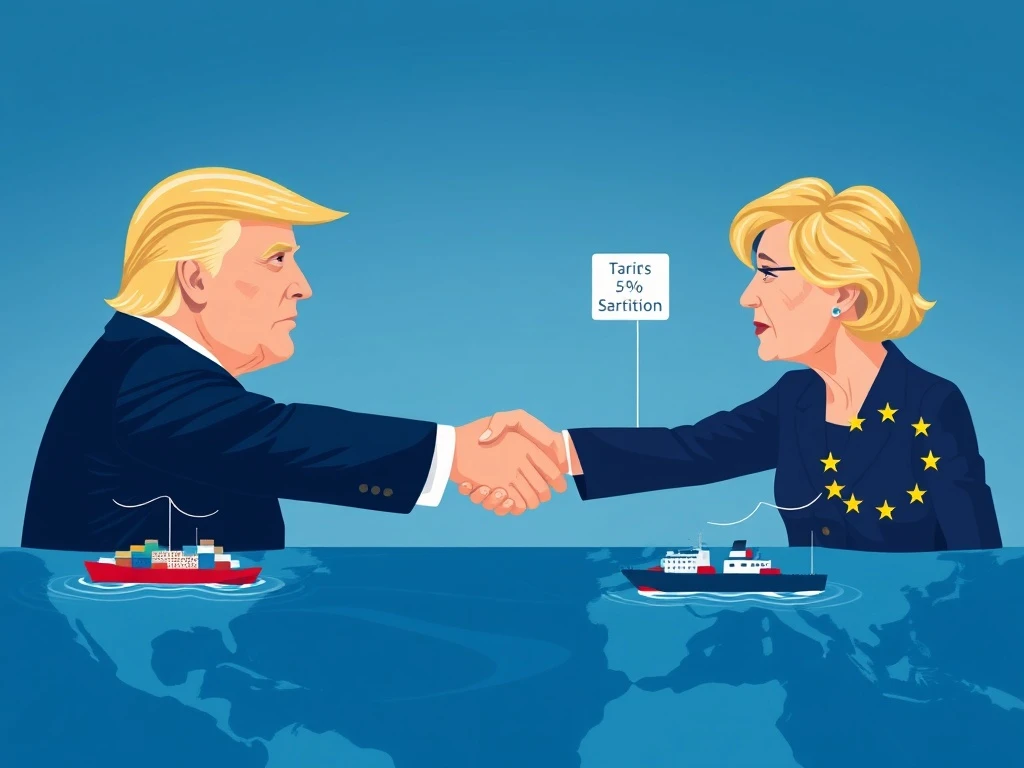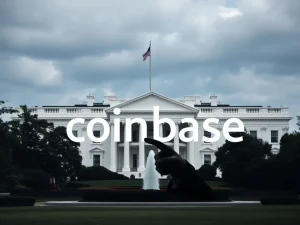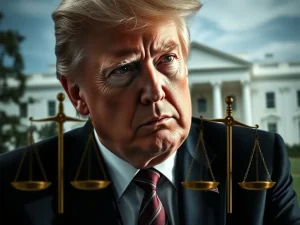Strategic Breakthrough: Trump Secures Monumental EU Trade Deal Amidst Global Trade Shifts

In the ever-evolving landscape of global economics, shifts in international trade policy can send ripples across all financial markets, including the dynamic world of cryptocurrencies. While seemingly distinct, the macroeconomic forces shaped by significant agreements like the recent Trump EU trade deal have profound implications for investor sentiment, capital flows, and ultimately, the stability that underpins digital asset valuations. Let’s dive into the details of this groundbreaking agreement and understand its potential far-reaching effects.
Unpacking the Monumental Trump EU Trade Deal
President Donald Trump recently announced a significant trade agreement with the European Union, marking a pivotal moment in international economic relations. This comprehensive deal includes a substantial $600 billion investment by the EU into U.S. infrastructure and manufacturing sectors. Beyond direct investment, the agreement also secures $750 billion in purchases of American energy products and “vast amounts” of weapons, showcasing a multifaceted approach to bolstering the U.S. economy and its strategic interests.
In return for these considerable commitments, the U.S. has agreed to impose a 15% tariff on EU exports. This framework mirrors a prior arrangement with Japan, which saw a pledge of $550 billion in investments to key U.S. industrial sectors under a similar 15% tariff structure. The administration views these agreements as a testament to its strategy of leveraging economic influence to secure favorable terms, particularly as it looks ahead to more complex negotiations.
Key components of the EU deal include:
- $600 Billion Investment: Directed towards U.S. infrastructure and manufacturing, promising job creation and economic growth.
- $750 Billion Energy Purchases: A three-year commitment from the EU to buy American energy products, aligning with President Trump’s term.
- Strategic Weapon Sales: Significant purchases of U.S. weaponry, strengthening defense ties.
- 15% Tariffs: A lower rate than initially threatened (30%), attributed to innovative financing mechanisms within the agreement.
The Strategy Behind EU Tariffs and US Trade Policy
The imposition of EU tariffs at a 15% rate, rather than the initially floated 30%, highlights a key aspect of the U.S. administration’s negotiation tactics: using the threat of higher tariffs as a bargaining chip to secure investment pledges. Scott Bessent of the U.S. Treasury noted that innovative financing mechanisms within these agreements played a role in achieving the reduced tariff rate.
However, this aggressive US trade policy has not been without its critics or legal challenges. Legal experts and financial markets have scrutinized the administration’s reliance on the International Emergency Economic Powers Act (IEEPA) to justify these tariffs. A court hearing is scheduled to assess the lawfulness of the president’s use of this act, raising questions about the long-term enforceability and stability of these agreements. Analysts from Piper Sandler have expressed skepticism, arguing that the substantial investment pledges, like Japan’s $550 billion, lack concrete details and that the tariff policies may lack a solid legal foundation, potentially deterring long-term commitments from trading partners.
The administration’s approach aims to:
- Leverage Threats: Use the specter of high tariffs to compel trading partners into making significant investment and purchase commitments.
- Secure Investments: Prioritize direct foreign investment into U.S. sectors over traditional trade balance improvements.
- Innovate Financing: Explore new financial mechanisms to make deals more palatable and secure lower tariff rates.
Navigating Complex China Trade Negotiations
These agreements with the EU and Japan come as the U.S. intensifies its efforts to pressure China into further concessions during upcoming high-stakes China trade negotiations. The U.S. Treasury’s Scott Bessent and Chinese Vice Premier He Lifeng are slated to commence talks in Stockholm, with the current trade truce between the two economic giants expected to extend by 90 days beyond its August 12 expiration.
However, analysts widely caution that Beijing is unlikely to yield as easily as its trade partners. China’s economic resilience, its strategic position in global supply chains, and its more centralized economic control give it greater leverage than the EU or Japan. Jamie Cox of Harris Financial Group succinctly put it: while Japan and the EU had limited options but to comply, China “is unlikely to be as willing to fold” in ongoing discussions.
The challenges in dealing with China include:
- Economic Resilience: China’s vast domestic market and robust industrial base make it less susceptible to external pressure.
- Supply Chain Leverage: Its central role in global manufacturing gives it significant bargaining power.
- Strategic Objectives: China’s long-term economic and geopolitical goals may prioritize sovereignty over immediate trade concessions.
Broader Global Trade Impact and Market Reactions
The administration’s aggressive tariff strategy extends beyond major economic blocs. The U.S. has also imposed higher tariffs on other Asian countries, including 19% on the Philippines and Indonesia, and 20% on Vietnam. These measures are primarily aimed at deterring the trans-shipment of Chinese goods through these nations, reflecting a comprehensive effort to enforce trade compliance.
Financial markets have responded cautiously to these developments. U.S. stocks have fluctuated amidst the uncertainty surrounding evolving trade policy. While the Trump administration frames these deals as significant “wins” for American workers and industries, economists highlight the inherent risks of prolonged volatility stemming from shifting tariffs and potential retaliatory measures from trading partners. A report from the Hoover Institution underscored a critical concern: businesses may become hesitant to invest in an environment characterized by regulatory unpredictability.
The overarching global trade impact of these policies remains a subject of intense debate. While securing substantial investments, the reliance on aggressive tariff threats could strain relationships with key international partners, particularly as China’s resistance to trade demands appears to solidify. The balance between securing immediate economic concessions and maintaining stable long-term international trade relations is a delicate one.
Conclusion: A New Era of Trade Dynamics?
The Trump EU trade deal, alongside the agreement with Japan, marks a distinctive shift in global trade dynamics. These deals prioritize massive investment pledges and energy purchases in exchange for what the administration considers favorable tariff rates. While framed as successes for American interests, the strategy’s reliance on tariff threats and its legal standing continue to draw scrutiny. The true test of this approach will likely come in the ongoing China trade negotiations, where the U.S. faces a more formidable and less compliant adversary. As these complex trade narratives unfold, their ripple effects will continue to shape not just national economies, but also the broader landscape of global finance, including emerging markets like cryptocurrency.
Frequently Asked Questions (FAQs)
What are the key components of the Trump EU trade deal?
The deal involves a $600 billion investment from the EU into U.S. infrastructure and manufacturing, $750 billion in purchases of American energy products and weapons, in exchange for a 15% tariff on EU exports to the U.S.
How do the EU tariffs compare to initial threats?
The 15% tariff rate on EU exports is significantly lower than the initial threat of 30%. This reduction is attributed to innovative financing mechanisms and the substantial investment pledges secured within the agreement.
What is the U.S. strategy behind these trade agreements?
The U.S. strategy centers on using the threat of higher tariffs as leverage to compel trading partners to commit to large-scale investments and purchases in American sectors. It prioritizes securing direct foreign capital inflows.
Why are analysts skeptical about the long-term stability of these deals?
Skepticism stems from concerns about the legal foundation of the tariffs, particularly the use of the International Emergency Economic Powers Act, and the lack of concrete details for some investment pledges. This legal uncertainty could deter long-term commitments.
How might China’s response differ from the EU and Japan?
Analysts suggest China is less likely to yield easily due to its strong economic resilience, strategic leverage in global supply chains, and distinct geopolitical objectives. Unlike the EU and Japan, China may have more options and less pressure to comply with U.S. demands.
What is the broader global trade impact of these policies?
The policies contribute to market volatility and regulatory unpredictability, potentially discouraging business investment. While securing immediate economic benefits, they risk straining relationships with key trading partners and could lead to retaliatory measures, affecting global economic stability.










